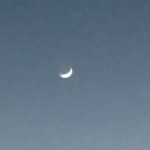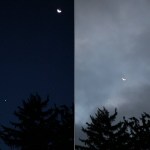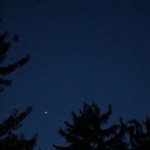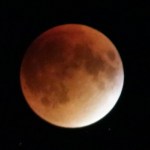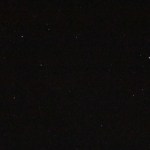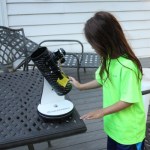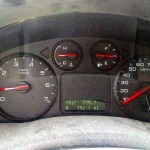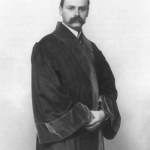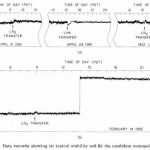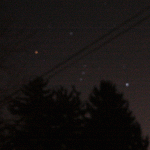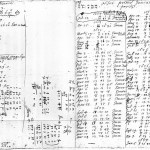Astronomy
Another month, another set of blog posts. This one includes the highest traffic I think I've ever seen for a post, including the one that started me on the path to a book deal:
-- The ALPHA Experiment Records Another First In Measuring Antihydrogen: The good folks trapping antimatter at CERN have now measured the hyperfine spectrum of hydrogen, which is a good excuse to explain what that is and why it matters.
-- 7 Suggestions For Succeeding In Science In College: It's the time of year when lots of people give unsolicited advice to the college-bound, and who am I to buck that trend?
-- How To…
Having picked up a new phone last week, it seems sort of appropriate to give a photo-a-day to a picture taken with that phone, as a kind of test. Also, I realized while on the way to SteelyKid's taekwondo class that I had forgotten to take any photos with the good camera, and wanted some insurance.
So, here's a shot of the very early crescent moon just after sunset, taken from the parking lot at Panera where we got dinner before class.
Crescent moon just after sunset, taken with my new phone.
Which, you know, isn't too bad, given the kind of difficult lighting conditions. This is, of…
In yesterday's crude astrophotography post, I mentioned that the conjunction of Venus and the Moon would be closer this morning, but I took a shot of it yesterday because there's no telling with the weather here this time of year. When I first went outside this morning, though, the sky was beautiful and clear and I said "Wow, that'll be a great shot after all."
Then I went inside to eat breakfast, and when I came back out, clouds had rolled in.
There were occasional breaks, though, and I did manage to get a fortuitous alignment of two of those with the bodies in question. which let me make…
One of the few problems with the new camera is that the Canon software that talks to it only runs on my laptop, not my home desktop. This is an issue partly because the laptop has less disk space (I got it with the biggest SSD available a few years ago, which is small compared to the spinny-disk drives in the desktop), but a bigger issue for image processing is the display, which shifts colors dramatically as you change the viewing angle. This isn't a big issue for daylight photos of the kids, where the camera does pretty well already and the GIMP auto-level tool handles the few color issues…
Really, was there any question at all what the subject of today's photo would be? I mean, I'm a geek, I have a fancy camera-- of course I was taking pictures of the lunar eclipse. But more importantly, I was sharing it with SteelyKid:
SteelyKid looking at the eclipse through her telescope.
That's SteelyKid looking through her telescope at the early stages of the eclipse. The light is from the lamp in our front yard, which would be no good at all for trying to see anything actually faint, but isn't really an issue when you're looking at the full moon.
The telescope-- a Celestron FirstScope…
Today was Rosh Hashanah-- happy new year to those who celebrate it-- meaning that both SteelyKid's school and The Pip's day care were closed. In an effort to maintain my sanity while keeping them entertained, I took them to the local science museum to rampage through hands-on exhibits. We also caught the planetarium show, because why not.
The show wasn't really pitched right for my 7- and 3.8-year-olds, but it did make me wonder how the new camera would do at photographing the sky. And it's pretty clear tonight, so here's a shot of the sky more or less straight up at about 9pm Eastern:
Stars…
Today is SteelyKid's seventh birthday, which she's been counting down to for a good while. It's a little hard to believe it's seven years since she was substantially smaller than her stuffed Appa toy.
She's become quite a handful in that time, with boundless energy apparently derived from photosynthesis (since she hardly eats anything), and intense interests in Minecraft and Pokemon, math and taekwondo. She's a red belt now, which is only a few short of black, and this summer has started doing the "Elite Team" sparring classes. I'm pretty sure that if she really wanted to, she could kick my…
I spent the last few days in Ontario, attending the Convergence meeting at the Perimeter Institute. This brought a bunch of Perimeter alumni and other big names together for a series of talks and discussions about the current state and future course of physics.
My role at this was basically to impersonate a journalist, and I had a MEDIA credential to prove it. I did a series of posts at Forbes about different aspects of the meeting:
-- The Laser Cavity was Flooded: a revisiting of the idea of True Lab Stories, which was a loose series of funny disaster tales from the early days of…
I've been really busy with year-end wrap-up stuff, but have also posted a bunch of stuff at Forbes. which I've fallen down on my obligation to promote here... So, somewhat belatedly, here's a collection of physics-y stuff that I've written recently:
-- Using Atoms To Measure Tiny Forces: A post reporting on some very cool atom interferometry experiments, one working to measure the very tiny (but known to exist) force of gravity, the other searching for a possible "fifth force" sort of thing.
-- Making And Shaking New Materials With Ultracold Atoms: A post reporting on a couple more DAMOP…
"Hey, Daddy, did you know that in five or six million years the Sun is going to explode."
"It's five or six billion years, with a 'b.'"
"Right, in five or six billion years, the Sun's going to explode."
"Well, a star like our Sun won't really explode. It'll swell up really big, probably swallow the Earth, and then kind of... go out."
"Right, and then it would be dark all the time. So we'd need to build a really big lamp."
"Well, in five or six billion years, maybe we'd just build a new star."
"How would we do that?"
"Well, you know, you just get a really big bunch of hydrogen together."
"Oh,…
There was some Twitter chatter the other night about a new arxiv paper called The Gender Breakdown of the Applicant Pool for Tenure-Track Faculty Positions at a Sample of North American Research Astronomy Programs:
The demographics of the field of Astronomy, and the gender balance in particular, is an important active area of investigation. A piece of information missing from the discussion is the gender breakdown of the applicant pool for faculty positions. For a sample of 35 tenure-track faculty positions at 25 research universities advertised over the last few years in astronomy and…
I've done yet another piece for The Conversation, this one expanding on something I've been saying in interviews promoting Eureka: that knowing the process of science can help people sort good science from bad. In this particular case, I take the somewhat #slatepitch-y angle that the recent high-profile unraveling of the BICEP2 experiment's claim to detect primordial gravitational waves is a good thing:
Along with general disappointment, the new announcement has prompted discussion of what, if anything, the BICEP2 team did wrong. Many commentators fault them for over-hyping their results to…
(When I launched the Advent Calendar of Science Stories series back in December, I had a few things in mind, but wasn’t sure I’d get through 24 days. In the end, I had more than enough material, and in fact didn’t end up using a few of my original ideas. So I’ll do a few additional posts, on an occasional basis, to use up a bit more of the leftover bits from Eureka: Discovering Your Inner Scientist…)
While we mostly think of science being done in comfortable institutes if not gleaming laboratories, one of the most impressive and inspiring things about science is that people can and do carry…
(When I launched the Advent Calendar of Science Stories series back in December, I had a few things in mind, but wasn't sure I'd get through 24 days. In the end, I had more than enough material, and in fact didn't end up using a few of my original ideas. So I'll do a few additional posts, on an occasional basis, to use up a bit more of the leftover bits from Eureka: Discovering Your Inner Scientist...)
One of the tricky things about writing this book was that I didn't just need stories from the history of science, but stories that fit a particular pattern. The point of the book, after all, is…
(That title doesn't quite scan as is, but if you stick an "a" in there, you can sing it to the tune of a song from "Fiddler on the Roof"... You're welcome.)
The last time I taught my "Brief History of Timekeeping" seminar was in 2012, so I spent a bunch of time on the Mayan calendar. This time around, we've lost the obvious pop-culture hook, but it's still so weird and fascinating that I spent a class on it last week. One of the things we talked about was what this system (what we know of it) says about the Maya concept of time. There's a very obvious contrast between the interlocking…
I'm teaching my "Brief History of Timekeeping" class again this term, and as always, I'm tweaking things a bit. This is one of our "Sophomore Research Seminar" courses, intended to introduce students to academic research, so it's not specifically a physics class, but I'm choosing to take the statements about research outside the student's field at face value, and thus will be requiring them to do final projects involving some empirical measurement of the natural world, that being the essence of scientific research. (Last time, I included that as an option, but nobody took it, so I ended up…
Over at Medium, they've published a long excerpt from Eureka: Discovering Your Inner Scientist, that gives a good flavor of what the book's really like. It's about how the process for solving hidden-object games like the classic Where's Waldo books is comparable to the process used by Henrietta Leavitt to revolutionize our understanding of the universe:
There are multiple web sites and academic papers devoted to computer algorithms for locating Waldo within Handford’s drawings, using a variety of software packages, and these are impressively complex, running to hundreds of lines of code and…
Speaking of the timing of astronomical phenomena, as we were yesterday, the timing of celestial bodies was the key to the first demonstration of one of the pillars of modern physics, the fact that light travels at a finite speed. This actually pre-dates yesterday's longitude discoveries, which I always forget, because it seems like it should've been a later development.
The first really convincing demonstration that light doesn't cover arbitrary distances instantaneously dates from 1676, and was the work of the Danish astronomer Ole Rømer. Under the direction of Giovanni Cassini at the Paris…
Returning to our mostly-chronological ordering after yesterday's brief excursion, we come to one of the great problems of the 1700's, namely determining the longitude at sea. Latitude is easy to find, based on the height of the Sun at noon-- we told that story last week-- but longitude is much trickier. Thanks to the rotation of the Earth, the best way to measure longitude is by measuring time-- if you know what time it is where you are, and what time it is at some reference point (now established as Greenwich, UK), the difference between those times tells you the difference in longitude.…
The final step of the scientific process is to share your results with others, and that's the step where things are most prone to breaking down. Countless great discoveries have been delayed or temporarily lost because the people who made them were more concerned with protecting "their" secrets than with sharing new knowledge with the world. A classic example of this, that I first heard from Michael Nielsen, is Robert Hooke in 1676 first reporting the relationship for elastic forces as "ceiiinossssttuv," which unscrambles to "ut tensio, sic vis," indicating that the force is proportional to…
